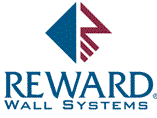- Staining Concrete
- Stamped Concrete
- Concrete Overlays
- Concrete Resurfacing
- Concrete Polishing
- Concrete Dyes
- Colored Concrete
- Indoor Concrete
- Concrete Floors
- Concrete Countertops
- Garage Floor Coatings
- Furniture, Sinks, Fire Bowls
- Basement Floors
- Outdoor Concrete
- Concrete Patios
- Concrete Driveways
- Concrete Pool Decks
- Outdoor Kitchens & Counters
- Outdoor Fireplace
- Concrete Walkways
- Concrete Pavers
- Concrete Walls
- Repair & Maintenance
- Foundation Repair
- Concrete Crack Repair
- Concrete Sealers
- Building with Concrete
- Concrete Homes
- Concrete Basements
- Decorative Concrete
LEED™ and Green Building with Reward Walls iForm
Much is currently being written about LEED credits and green building, but understanding how a typical product can fit within the LEED system can be difficult. The following information briefly describes the goals and benefits of working with LEED and outlines the categories where the benefits of Reward Wall Systems can assist a project in qualifying for LEED credits.
The United States Green Building Council, (USGBC), had clear objectives and benefits in mind in founding the LEED Rating System. These objectives include: reducing the depletion of our natural resources, making green construction more profitable, creating a safer, more comfortable interior environment, and minimizing strain on local infrastructure. Building Green offers important benefits including competitive initial costs, reduced operating costs, increased building valuation, greater durability, improved employee productivity, and reduced owner liability.
To embrace these goals and gain these benefits, a significant number of owners of government buildings, schools and other commercial projects are beginning to specify LEED in design and construction. Right now in the U.S. there are 166 LEED certified projects and 1,802 registered projects. When the design team registers a project, they are indicating they intend to complete all steps necessary to apply to become LEED certified. Registration is the first step in the process and brings with it access to the various tools and resources available on the USGBC website.
LEED (Leadership in Energy & Environmental Design) is a system or standard of measurement for designing, constructing, operating and certifying a building to a "Green" standard. It is a whole-building, integrated design process. The whole-building approach encourages and guides a collaborative and integrated design and construction process. All components of and within the building are evaluated to determine the LEED points. There are four levels of LEED certification:
LEED Certified 26-32 points
Silver Level 33-38 points
Gold Level 39-51 points
Platinum Level 52+ points (69 possible)
The higher the number, the greater the amount of LEED related objectives and benefits that have been incorporated and achieved within a project.
LEED and Reward
Reward ICFs do not provide any points for LEED certification by themselves. However, when taken together with other components of the building, they contribute to the LEED points awarded. Reward can also contribute to prerequisites that exist for some categories. These prerequisites are not awarded any points, but must be met to enable a project to qualify for LEED certification.
Of the six credit categories for which points are awarded, the first two categories, Sustainable Site and Water Efficiency are concerned with the building site, landscaping, and water usage, and Reward ICFs do not contribute in any of these areas.
In the third category, Energy and Atmosphere, Reward ICFs can help a project qualify for prerequisite energy performance standards and up to 10 LEED points for optimized energy performance. Points are awarded on a graduated scale ranging from one point if the energy performance of the new construction is 15% better than the prerequisite requirement to ten points awarded if the energy performance is 60% better than the required minimum standards.
Reward ICFs can help projects qualify for credits under the fourth category, Materials and Resources, because points are awarded for recycling construction waste from the jobsite. A project can earn one point for diverting 50% of total construction waste away from landfills, and two points for diverting 75% of all waste generated for the entire project. This can be calculated by weight or by volume. Virtually all of the Reward waste is recyclable – forms, rebar and concrete.
Reward ICFs also contribute because the ties within the forms are made of post industrial recycled plastic. A project earns one point if 5% of the total materials used are recycled and two points if 10% are. Approximately 20% of the iForm uses post-industrial recycled content. Specific calculations would be necessary for each project, in which the recycled content of Reward would be factored in with all of the recycled construction materials from the total project.
Finally, Reward can contribute to awarded credits within Materials and Resources for local/regional materials. The project can earn one point if 20% of all of the project's materials are manufactured within a 500 mile radius and two points if 50% are. In many cases Reward ICFs are produced in close proximity to the job site, and the concrete and rebar also can be obtained locally.
For Indoor Environmental Quality Reward ICFs can help a project qualify for thermal comfort credits. The reduced air infiltration and thermal mass of Reward walls moderates internal temperature fluctuations and helps control humidity.
A final category allows for designers to apply for LEED credits for new or creative approaches under Innovation and Design Process. Thelong life cycle of the Reward concrete structure and enhanced mold growth control are features of our system that might help a project earn additional points within this category.
For more information about the LEED certification program, go to www.leedbuilding.org. Here you can find examples of past LEED certified projects, how to register, the fee structure, LEED Rating System guides, and other references.
To learn more about Reward Wall Systems, Inc. visit www.rewardwalls.com.
Related Information:

4115 South 87th Street
Omaha, Nebraska 68127
Toll Free 1.800.468.6344
Ph: 402.592.7077
Fax: 402.592.7969
www.rewardwalls.com





